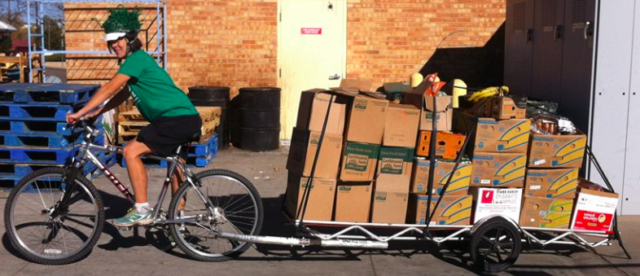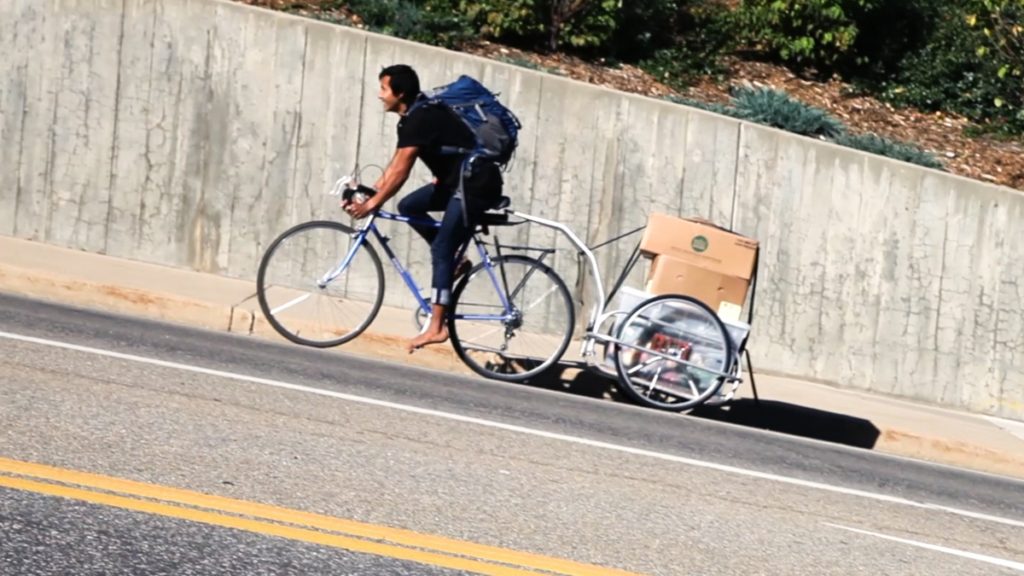
In an alley behind Whole Foods, Jim Kastengren, a long-time volunteer with Boulder Food Rescue, is showing me the ropes. In front of us are boxes of fresh produce the store can’t sell. Kastengren’s rule of thumb, he tells me, is that if he wouldn’t personally eat the donated food, it goes in the compost bin. The rest of it goes directly to people in need around Boulder.
I heave a bag of potatoes up from the donation pile and plop them into the trailer attached to Kastengren’s bike. We start piling the rest of the food on top of it — apples, oranges, yogurts. We save the bananas for last, balancing them in between boxes.
I could barely lift the single bag of potatoes, but Kastengren is about to bike uphill pulling more than 100 pounds of food toward Attention Homes, a nonprofit that provides resources for at-risk youth. Boulder Food Rescue delivers, on average, 1,300 pounds of food a day.
The organization was founded in 2011 by a group of friends who did some research in collaboration with Community Food Share and learned that enough food goes to waste every day in Boulder and Broomfield counties to feed every food-insecure person living in these areas.
Hana Dansky, co-founder and current executive director of Boulder Food Rescue, says that what makes the program unique is the model, which cuts out the middleman between food donations and recipients.
“Some of the reasons why the food isn’t getting to these people is because with the traditional food bank model, by the time you take perishable items like fruits and vegetables to the warehouse, sort them and then redistribute them, days can pass and they can go bad,” she says.
With Boulder Food Rescue, this time frame is dramatically reduced. Volunteers pick up donations from local grocery stores (and a few local restaurants), sort through the food to make sure that it is all still edible and fresh, and then bike it directly to a neighborhood where people lack access to fresh fruits and vegetables.

The organization aims to fill the gap left behind with the traditional food redistribution model by focusing on perishable foods. They leave shelf-stable items to the traditional food banks in town, which Dansky says are best suited for that kind of food donation.
And using bikes seemed like a natural fit for delivery, as the founders were already bikers, and they wanted to minimize their environmental footprint as much as possible.
“We’re doing something really positive for the environment in that way (trying to reduce food waste) and so driving cars seemed kind of silly,” Danksy says. “Most people think that riding bikes full of food is sort of silly, but we kind of had this other approach to it in that way: It doesn’t make sense to drive a car when food is being thrown away blocks from where people need it.”
Boulder Food Rescue prides itself on listening to the people who get the donations, and allows each community to use the donation how they see fit.
“What the Boulder Food Rescue is doing differently is breaking down that barrier of people having to go to the pantry to get food,” says Kate Eno, volunteer coordinator. “There are multiple barriers there: There’s the geographic barrier, there’s the mobility barrier and there is a stigma barrier.”
And removing the middleman allows for communities to have a certain amount of autonomy with the donations they receive.
“We go straight to a low-income housing site where there’s lots of people that want access to healthy fruits and vegetables that they wouldn’t have otherwise, and residents there redistribute however they want,” Dansky says. “It’s their program, so we just support them on the back end.” Most of these communities set up no-cost grocery programs, but each is unique.
Now, five years in, roughly 100 volunteers run more than 70 shifts a week, Eno says. On the website, volunteers can sign up for or give up shifts, and log their deliveries.
Not only has Boulder Food Rescue grown dramatically as an organization, it has also inspired other cities to form similar programs and led to the creation of the Food Rescue Alliance.
Dansky describes the group as a peer-learning network that shares documents, stories, practices and resources. Boulder Food Rescue puts on workshops every two months on subjects requested by members. Dansky says that the leader of a workshop may be an organization within the alliance or an outside source.

No matter where a member of the alliance may be, Dansky says certain core values, such as healthy foods, stay the same, even as the model changes to adapt to a city’s specific set of challenges. She believes in many ways Boulder Food Rescue is an individual model, and other cities need to adapt it to find a system that works best for their home. For example, “Being bicycle-based has been huge for us in terms of volunteer engagement, but in Colorado Springs, that looks a lot different because that city is a lot more sprawling and there’s not as big of a bike scene,” Dansky says. “So they might not do bike-based stuff but they do something else really well.”
Kastengren has been volunteering with Boulder Food Rescue since the year it was founded and says he keeps coming back, not only to volunteer and help people, but also as a reminder to stay humble and appreciative. Behind that Whole Foods, Kastengren reflects on just what makes this work important to him.
“I appreciate the idea of taking food that would otherwise go to a landfill and have it eaten by someone who can really use it and appreciate it,” he says. “We’re so affluent in Boulder in general, and we don’t tend to appreciate what we have. And this is something that points out how much we have. This was just waste; it was just going into a dumpster before… And we take it to places where if it weren’t for this, these people wouldn’t have good food to eat.”














